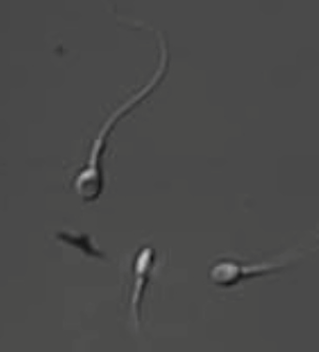Ion channels and human sperm
Interview with
We know from work in mice, that sperm use certain ions like potassium,  to control their activity. And while ion channels to admit potassium have been found in mice, no one had found the human equivalent until now.
to control their activity. And while ion channels to admit potassium have been found in mice, no one had found the human equivalent until now.
Nadja - We wanted to identify a potassium-iron channel in humans spermatozoa. Sperm are highly differentiated cells and their task is to carry genetic material of the father, fuse with the egg, and produce offspring. And to do that, they depend on several chemical compounds such as electrolytes, sodium, potassium, calcium, magnesia. These compounds cannot enter or leave the cell just as they want. Sperm cells have to have pores in their membrane, and these pores, we call ion channels. Two of such ion channels have been identified, a calcium channel, the other is a proton channel and both of these channels are dependent on membrane potential. And the membrane potential is being set by potassium ion channels. For mice, the identity of a potassium channel has been characterised, but such data were not available for human sperm.
Chris - So, we know that there has to be a potassium channel on the human sperm because we know it's there in mice, and it's fundamental to how the mouse sperm does its job. So, the question is, what is it and how does it work, can we identify it?
Nadja - Exactly. We addressed this question to apply the so-called 'patch clamp' technique to the cells. This is an electrophysiological technique. You record electrical currents of the cell, which gives you an answer - is there an active potassium channel present in these cells? By applying specific inhibitors, you can then fingerprint the pharmacological profile.
Chris - So, you took some human sperm and you applied this patch clamp technique which enabled you to study how ions were going back and forth, in and out of the sperm. And you've been able to identify what must be a potassium channel on the human sperm. Is it the same as the one that we find in mice?
Nadja - No, it's a totally different channel. The potassium channel in mouse sperm is called the SLO3 channel, and this channel is activated when the intracellular pH rises. In human sperm, changes of intracellular pH do not activate the potassium channel. In human sperm, changes of intracellular calcium activate the channel.
Chris - So, this must be some kind of evolutionary solution to the way that human and mouse mating habits differ.
Nadja - Yes. It could also be, if we'd look on the genes for that SLO3 channels in mice and the so-called SLO1 channel in humans, they share a certain amount of homology. It's about 50 or 60%, and you could think that at some point during evolution, mice and humans diverged from each other.
Chris - So, what are the implications of finding this new potassium channel? Does this open up a new ability for us to manipulate the behaviour of sperm or the activity of sperm, and does it also explain why some people can't get pregnant?
Nadja - Yes. Identifying an ion channel helps to understand how male fertility works. So having identified SLO1 as the principal potassium in human sperm, it might open up research on a genetic level to screen men, whether they have a genetic defect in the SLO1 coding gene, and then think about perhaps about a proper treatment.
Chris - And looking at the flip side of the coin, what about contraception?
Nadja - Yeah. This is a very good point when you try to solve questions, what could cause male infertility. You could also think about developing a male contraceptive. The findings, we have published could be the basis to develop a male contraceptive but I have to say, if you want to develop a male contraceptive, you have to make sure that this drug only affects sperm or developing sperm cells, and not other cells of the body. SLO1 has been shown to be expressed and conduct potassium ions in nerve cells as well as in muscle cells.
Chris - So, that means then that it would be quite difficult to come up with a discrete blocker unless you used or exploited some other function of the sperm to target that.
Nadja - Exactly.










Comments
Add a comment